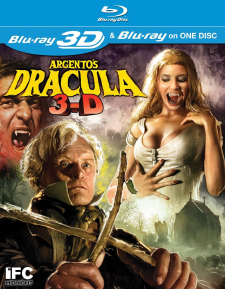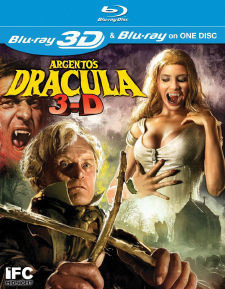Dracula 3D (Blu-ray 3D Review)

Director
Dario ArgentoRelease Date(s)
2012 (January 28, 2014)Studio(s)
IFC Midnight- Film/Program Grade: C-
- Video Grade: B
- Audio Grade: A-
- Extras Grade: B-
Review
So, let’s get this out of the way right up front: Dracula 3D (aka Dario Argento’s Dracula) has some of the worst CGI ever committed to a feature film. We’re talking about The Langoliers level of quality here, and without the excuse of it being in a cut-rate television miniseries, either. The praying mantis alone is absolutely unforgettable, and that’s not a compliment. With that out of the way, the rest of Dracula 3D is nowhere near as bad as its reputation would indicate. It certainly doesn’t “rekindle the grandeur of Dracula,” in the typically hyperbolic words of a certain former Entertainment Weekly writer in his review of the film, but it doesn’t exactly extinguish that grandeur, either. The low budget sometimes means that everything looks as cheap as it actually was, and the acting can be wildly variable, but it’s still an interesting take on the legendary character.
The script from Argento, Enrique Cerezo, Stefano Piani, and Antonio Tentori does take liberties with Bram Stoker’s novel, but no more so than many other versions. To be fair, the film is titled Dario Argento’s Dracula, not Bram Stoker’s Dracula, so at least it’s far more honest about its own creative license than Francis Ford Coppola’s version was. (Without a trace of conscious irony, Coppola’s film had the cheek to put that title on the screen right after a lengthy prologue that had nothing to do with Stoker’s book.) Many of the changes in their script were clearly necessitated by the limited budget, like confining the entire story to Transylvania, and eliminating or condensing many characters. Unfortunately, they also borrowed the Dracula/Mina star-crossed romantic angle from the Coppola film, which is a trope that really needs to have a stake driven through its heart, though at least it resolves more appropriately in this version. Pro tip for future filmmakers: Dracula isn’t a tragic romance. Find new source material.
Thomas Kretschmann is surprisingly good as Dracula, and even more surprising, he’s far more credible than Rutger Hauer is as his counterpart Van Helsing. Hauer, unfortunately, looks as worn-out and tired as he probably was feeling by this point of his career. One would have hoped for more sparks in the only collaboration between Hauer and Dario Argento, but they just didn’t happen. Dracula was also Argento’s only foray into 3D filmmaking, and sadly he didn’t do anything particularly interesting with the format. Given the creative and innovative ways that he had incorporated color and music into his earlier films, it would be reasonable to expect that he would do something similar with 3D, but the effects aren’t integrated into the fabric of the film in a fundamental way. Dario Argento’s Dracula is still enjoyable in 3D, but watching it in 2D doesn’t take very much away from the experience.
Cinematographer Luciano Tovoli captured Dracula 3D digitally using twin ARRI Alexa cameras, with everything finished as a 2K Digital Intermediate, and framed at 2.35:1 for its theatrical release. While the imagery is crisp and clear, it retains a harsh digital appearance throughout that detracts from the period setting. This is one case where extreme clarity can be counterproductive, as it adds to the cheap appearance of the film. Despite the widescreen and the 3D, it tends to look like a made-for-television production. The colors are good, but the contrast runs hot, with highlights that veer towards being blown out. All of that is equally true of both the 3D and the 2D versions. The 3D does add a decent amount of depth to many of the shots, as well as a handful of pop-out effects, but none if it impacts the film in a significant way.
Audio is offered in English 5.1 DTS-HD Master Audio and English 2.0 LPCM, with optional English SDH and Spanish subtitles. It’s an extremely aggressive mix that proves just how well that sound can complement the experience of watching a 3D film. Effects are placed precisely all around the viewer to provide an aural version of 3D imaging, and many of the sounds track with the visuals through 3D space. Claudio Simonetti’s score also sounds quite good, although some of his synthesizers do feel a bit anachronistic at times. While a 3D display may not be absolutely necessary to experience Dario Argento’s Dracula, a good multichannel setup definitely is.
The following extras are included, all of them in HD:
- Behind the Scenes (63:53)
- Kiss Me Dracula Music Video (5:10)
- Trailer (1:28)
- Red Band Trailer (1:47)
Surprisingly enough, for a film that failed to ignite either the critical or the popular imaginations, Behind the Scenes is a proper making-of documentary. It includes interviews with the cast and crew, as well as footage from the set. It covers all aspects of the production, and yes, even the praying mantis gets some love. The most interesting part is a detailed examination of the 3D process that was used in the film. None of it is going to change anyone’s mind about Dracula 3D, but it’s still worth a look. Kiss Me Dracula is a music video from the Simonetti Project, featuring Silvia Specchio on vocals. It combines footage of the band performing the song with clips from the film, with Simonetti—well, you’ll just have to see what he does for yourself. It can be viewed in either 2D or 3D, with 4.1 DTS-HD Master Audio.
It’s not an extensive collection of extras, but one good documentary is worth a dozen static interviews. Whether or not a film like Dario Argento’s Dracula deserves that kind of attention is a fair question, but frankly, a good extra is a good extra. Dracula may or may not be a good film, but again, it’s still not as bad as many people seem to think. Late-period Argento has always been divisive, so Dracula is hardly alone in that regard. If you keep your expectations firmly in check, it’s definitely worth a look.
- Stephen Bjork
(You can follow Stephen on social media at these links: Twitter and Facebook.)

